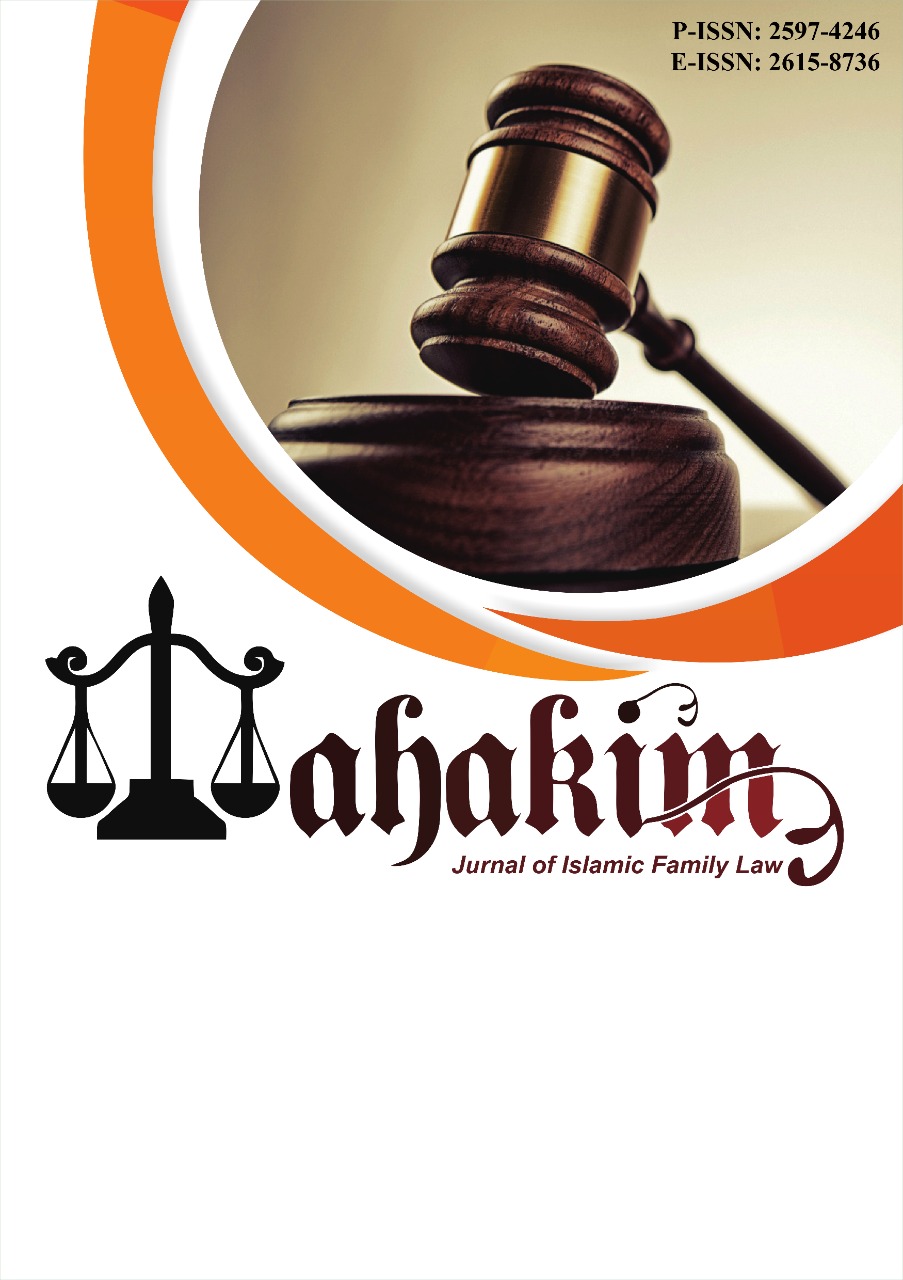The Relativity of Feminist Legal Theory on Abortion According to Fiqh Dharūrāt
DOI:
https://doi.org/10.30762/mahakim.v8i2.622Keywords:
Abortion, Feminist, Relativity, Fiqh Dharūrāt, Feminist Legal TheoryAbstract
This study seeks to analyze the epistemological problems from the theories of feminism and their critical point of legalizing abortion from the perspective of sharī'ah through the analysis of fiqh dharūrāt. The method applied is descriptive-analytical with a philosophical approach that aims to analyze the paradigm behind the Dominance Theory, Critical Race Theory, and Postmodernism Theory, which feminists have promoted as the protection of women. The results of this study conclude that dominance theory provides the legality of abortion rights based on the doctrine of the sovereignty of a female’s body without being bounded by morals or other values, including religion. Critical Race Feminist theory used the standard of abortion by considering women's discrimination experiences between white women and black women that create the issue of reproductive health as a form of fulfilling the right of all women's authority to get reproductive health services and determine the future of their bodies. Similarly, postmodern theory explains the legality of abortion rights without being bound by specific moral standards, and the assessment of good and lousy abortion behavior was not left by the justification of society but by the beliefs of the woman. Based on the philosophical basis of the three feminist theories above, the standard of dharūrāt on abortion rights becomes relative and flexible. Fiqh dharūrāt provided the guidance to prevent women from being trapped into relativism so that they could remain in the guidance of revelation and guidance of the sharī'ah.
References
Abū Al-Ḥārits Al-Ghazī, M. Ṣidqī bin A. bin M. A.-B. (1416). Al-Wajīz Fī Īḍāḥī Qawā‘id al-Fiqhiyyah al-Kulliyyah. Mu’assasah al-Risālah al-‘Ilmiyyah.
Al-Bayānūnī, M. A. al-Fatḥ. (2011). Fiqh al-Ḍarūrāt: Ma‘ālimuhu wa Ḍawābiṭuhu. Dār al-Iqrā’.
Al-Buṭī, M. S. R. (2003). Ma‘a al-Nās Masyrū ‘āt wa Fatwā. Dar al-Fikrī.
Al-Dubyān, A. ‘Umar D. bin M. (1426). Mausū‘ah Aḥkām al-Ṭahārah (Vol. 8). Maktabah Al-Rusyd.
Al-Fayumī, A. bin M. bin ‘Alī. (1909). Al-Miṣbāḥ al-Munīr fī Gharīb al-Syarh al-Kabīr. Al-Maktabah al-‘Ilmiyyah.
Ali, A. (2005). Keterpurukan Hukum di Indonesia (Penyebab dan Solusinya) (Kedua). Ghalia Indonesia.
Al-Zubaidī, M. bin ‘Abdul R. A.-Ḥusainī. (1965). Tāj al-‘Urūs min Jawāhir al-Qāmus (Vol. 10). Dār al-Hidāyah.
Al-Zuḥailī, W. bin M. (1405). Naẓariyyāt al-Darūrat al-Syar‘iyyah. Mu’assasah al-Risālah.
Al-Zuḥailī, W. bin M. (1418). Al-Tafsīr al-Munīr fī al-‘Aqīdah wa al-Syarī‘ah wa al-Manhaj. Dār al-Fikr al-Mu‘āṣir.
Arroisi, J., Zarkasyi, H. F., & Roini, W. (2023). The Relevance of Contemporary Epistemology on Existing Knowledge: A Critical Analysis of Western Scientific Worldview According to Al-Attas Perspective. Afkar: Jurnal Akidah Dan Pemikiran Islam, 25(2). https://doi.org/10.22452/afkar.vol25no2.7
Askia, R., Shafira, E., & Pertiwi, A. D. (2024). Socio Scientific Issue Tindakan Aborsi Akibat Pemerkosaan Ditinjau dari Perspektif Hukum Islam, Bioetika Kedokteran dan Hukum di Indonesia. Islamic Education, 3(2).
Ayoub, S. (2020). “Neither Desiring It, nor Transgressing Its Limits:”: Ethical Hierarchy in Islamic Law. In D. R. Vishanoff (Ed.), Islamic Law and Ethics. International Institute of Islamic Thought. https://www.jstor.org/stable/j.ctv19prr5b.6
Azizah, N., & Rafsanzani, R. (2022). Abortion Law due to Illness and Rape Victims in the Perspective of Islamic Law, Common Law System, Civil Law System. Spectrum Journal of Gender and Children Studies, 2(2). https://doi.org/10.30984/spectrum.v2i2.412
Bambang Waluyo. (1996). Penelitian hukum dalam praktek (Cet. 2). Sinar Grafika.
Beddu, M. J., & Putri, N. H. R. (2022). Aborsi dalam Perspektif Undang–Undang No. 36 Tahun 2009 Dan Hukum Islam. Addayyan, 17(1).
Binder, S. (2021). The Female Victim; Whose Story Is Written on Her Dead Body? Exploring the Gender Politics of Writing Female Victims and Their Traumas. In Women and Crime in Post-Transitional South African Crime Fiction: A Study of Female Victims, Perpetrators and Detectives. Brill. http://www.jstor.org/stable/10.1163/j.ctv1sr6j0t
Brahms, Y. (2020). Philosophy of Post-Truth. Institute for National Security Studies. http://www.jstor.org/stable/resrep23537
Brooks, A. A. (2023). The Intelligent Code Switcher :The Effects of Racial Code Switching on Perceived Intelligence. Muhlenberg College. https://www.jstor.org/stable/community.35273686
Brown, K. (2022). Understanding the Role of Race in Abortion Stigma in the United States: A Systematic Scoping Review. Journal of Sexual and Reproductive Health Matters, 30(1).
Brown, L. M. (2005). On Female Body Experience. Oxford University Press.
Butler, J. (1994). The Postmodern Turn: New Perspectives on Social Theory. Cambridge University Press.
Cheema, H. A. (2020). Construction of Authenticity in Islamic Law: An Analysis of Polygamy, Divorce, and Political Participation of Women. Islamic Studies, 59(4). https://www.jstor.org/stable/27088413
Cockrill, K., & Nack, A. (2013). I’m Not That Type of Person: Managing the Stigma of Having an Abortion. Deviant Behavior Journal, 34(12).
Edman, R. S. (1997). Feminism, Postmodernism and Thomism Confront Questions of Gender. In A. O. Simon (Ed.), Postmodernism and Christian Philosophy. American Maritain Association.
El-Hissy, M. (2020). Of Maidens and Virgins or, Sparking Military Alliance the Affective Politics of the Pristine Female Body. In Strategic Imaginations: Women and the Gender of Sovereignty in European Culture. Leuven University Press. https://doi.org/10.2307/j.ctv1bd4h91.6
Fassin, D. (2001). The Biopolitics of Otherness: Undocumented Foreigners and Racial Discrimination in French Public Debate. Royal Anthropological Institute of Great Britain and Ireland, 17(1).
Grosz, E. A. (1994). Volatile Bodies: Toward a Corporeal Feminism. Indiana University Press.
Hakiim, A., Abdullah, M., & Romelah. (2022). Tindakan Aborsi Akibat Pemerkosaan Ditinjau Menurut Pandangan Islam, Bioetika Kedokteran dan Hukum di Indonesia. Jurnal Health Sains, 3(3).
Heymann, J., Sprague, A., & Raub, A. (2023). Gender Discrimination at Work. In Equal Rights at Work for Women Must Mean All Women. University of California Press. https://www.jstor.org/stable/jj.1791908.8
Hudiyani, Z. (2021). Diskursus Aborsi Dalam Perspektif Fikih Klasik Dan Kontemporer. Al-Ahwal Al-Syakhsiyyah: Jurnal Hukum Keluarga Dan Peradilan Islam, 2(1). https://doi.org/10.15575/as.v2i1.12172.
Humaira, F. (2023). Analisis Aborsi Bagi Perempuan Menikah Di Kecamatan Tanjung Pura. Journal Smart Law, 1(2).
Ibn Taymiyyah Al-Harānī, T. A. al-‘Abbās A. bin ‘Abdul Ḥalīm. (1416). Majmu’ Al-Fatāwā (Vol. 38). Fahd litibā‘ati al-Muṣḥaf al-Syarīf Al-Madīnah al-Nabawiyyah al-Mamlakah al-‘Arabiyyah al-Sa‘ūdiyyah.
KY, E., K, D., & GE, E. (2016). Black Lives Matter: Claiming a Space for Evidence-Based Outrage in Obstetrics and Gynecology. Public Health Journal, 106(10).
Lang, K., & Spitzer, A. K.-L. (2020). Race Discrimination: An Economic Perspective. The Journal of Economic Perspectives, 34(2). https://www.jstor.org/stable/26913185
Levit, N., & Verchick, R. R. M. (2006). A Primer: Feminist Legal Theory. NYU Press.
Minhas, Q. A. M., & Niazi, S. M. (2020). Abortion and Rape Laws in Pakistan: A Sharī‘ah-Based Analysis. Islamic Studies, 59(3). https://www.jstor.org/stable/27088401
Muhaimin. (2020). METODE PENELITIAN HUKUM (Pertama). Mataram University Press.
Muḥammad al-‘Aṭṭar, Ḥusnī. (2021). Al-Samāḥah al-Islāmiyyah fī Darūrat al-Syar‘iyyah. Mu’assasah Nāfidz lil Bahts wa al-Tibā’ah wa al-Nasyr.
O’Reilly, A. (Ed.). (2021). Maternal Theory: Essential Readings (2nd ed.). Demeter Press.
Rivera Rodriguez, G., Tamayo Acosta, J., Sosa Gomez, A. E., Marcucci Rodriguez, R. E., Rodriguez Cintron, G. A., & Acosta, M. (2022). The Medical and Financial Burden of Illegal Abortion. Cureus. https://doi.org/10.7759/cureus.30514
Ross, L. J. (2016). The Color of Choice: White Supremacy and Reproductive Justice. In Color of Violence: The INCITE Anthology. Duke University Press.
Ross, L. J. (2017). Reproductive Justice as Intersectional Feminist Activism. Souls Journal, 9(3).
Sagala, N. K. A., Khatami, N., & Lubis, F. (2023). Pidana Aborsi Dalam KUHP. As-Syar’i: Jurnal Bimbingan & Konseling Keluarga, 5(3). https://doi.org/10.47467/as.v5i3.2946
Shahaluddin, H. (2022a). Ideologi Gender dalam Studi Islam. INSISTS.
Shahaluddin, H. (2022b). Indahnya Keserasian Gender dalam Islam. INSISTS.
Simkulet, W. (2020). Abortion and Ectogenesis: Moral Compromise. Journal of Medical Ethics, 46(2). https://www.jstor.org/stable/27197783
Siraj, H. (2015). Kesaksamaan & Persamaan Gender: Pro dan Kontra Dari Perspektif Sosial dan Agama. Jabatan Agama Islam Selangor (JAIS).
Solikin, N. (2021). PENGANTAR METODOLOGI PENELITIAN HUKUM (Pertama). CV. Penerbit Qiara Media.
Sovia, S. N., Hasbullah, A. R., Mustakim, A. A., Setiawan, M. A. R., Rais, P., & Rizal, M. C. (2022). Ragam Metode Penelitian Hukum. Kediri: Lembaga Studi Hukum Pidana, Excellent, 12.
Stedman, T. L. (2008). The American Heritage Medical Dictionary. Houghton Mifflin Publisher.
Suleman, M. (2023). Muslim Personal Law, Yes and No: Religious Leader’s Views on its Legalization. Journal for the Study of Religion, 36(1). http://dx.doi.org/10.17159/2413-3027/2023/v36n1a
Suryani, L. (2021). Faktor-Faktor Pendorong dan Praktik Aborsi di Indonesia. Jurnal Studi Gender Dan Anak, 8(2). https://doi.org/10.32678/jsga.v8i02.5506
Syafuri, H. B., & Wahyudin, M. (2022). Perbandingan Hukum Terkait Aborsi Hasil Pemerkosaan Menurut Hukum Islam dan Positif. Formosa Journal of Social Sciences (FJSS), 1(3). https://doi.org/10.55927/fjss.v1i3.939
Tama, Y. A., & Rachmat, I. (2023). Aborsi: Kajian Dalam Perspektif Hukum Islam Dan Peraturan Perundangan Di Indonesia. Mandub : Jurnal Politik, Sosial, Hukum Dan Humaniora, 1(4). https://doi.org/10.59059/mandub.v1i4.464.
Vishanoff, D. R. (2020). The Ethical Structure of Imām al-Haramayn al-Juwaynī’s Legal Theory. In Islamic Law and Ethics. International Institute of Islamic Thought. https://www.jstor.org/stable/j.ctv19prr5b.5
West, R., & Bowman, C. G. (2019). Research Handbook on Feminist Jurisprudent. Edward Elgar Publishing.
Winters, E., & Esposito. (2010). Other People’s Daughters: Critical Race Feminism and Black Girls Education. Journal of Educational Foundations Journal, 24(1).
Yusdani. (2022). Aborsi Aman Sebagai Solusi Alternatif Atas Tingginya Angka Kematian Ibu Di Indonesia Dalam Tinjauan Ham Dan Hukum Islam. Tesis, Universitas Islam Indonesia, Yogyakarta.
Downloads
Published
How to Cite
Issue
Section
License
Copyright (c) 2025 Fahman Mumtazi, Henri Shalahuddin, Jannatul Munawarah

This work is licensed under a Creative Commons Attribution-ShareAlike 4.0 International License.
Authors who publish with this journal agree to the following terms:
- Copyright on any article is retained by the author(s).
- The author grants the journal, the right of first publication with the work simultaneously licensed under a Creative Commons Attribution License that allows others to share the work with an acknowledgement of the work’s authorship and initial publication in this journal.
- Authors are able to enter into separate, additional contractual arrangements for the non-exclusive distribution of the journal’s published version of the work (e.g., post it to an institutional repository or publish it in a book), with an acknowledgement of its initial publication in this journal.
- Authors are permitted and encouraged to post their work online (e.g., in institutional repositories or on their website) prior to and during the submission process, as it can lead to productive exchanges, as well as earlier and greater citation of published work.
- The article and any associated published material are distributed under the Creative Commons Attribution-ShareAlike 4.0 International License






